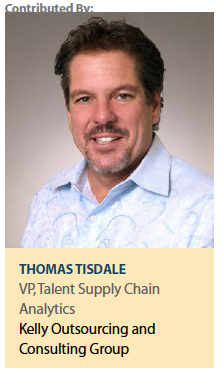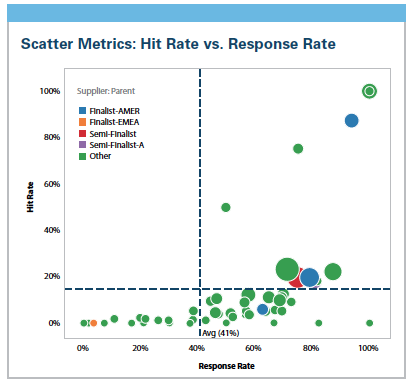 When it comes to the emerging trends in human capital management within the life-sciences sector, senior business leaders are anxious over the competitive landscape and the shrinking supply of skilled talent to help drive their R&D pipelines. What is less understood is that a strong workforce plan that includes external talent (temporary workers, independent contractors/freelancers, service providers, retirees, etc.) can make or break a company’s ability to achieve its strategic goals. Though the full-time labor force still accounts for the majority of the world’s workers, those numbers are shifting.
When it comes to the emerging trends in human capital management within the life-sciences sector, senior business leaders are anxious over the competitive landscape and the shrinking supply of skilled talent to help drive their R&D pipelines. What is less understood is that a strong workforce plan that includes external talent (temporary workers, independent contractors/freelancers, service providers, retirees, etc.) can make or break a company’s ability to achieve its strategic goals. Though the full-time labor force still accounts for the majority of the world’s workers, those numbers are shifting.
Comprehensive plans must rebalance the talent portfolio to account for the opportunity, risk, and cost factors that come with the external workforce.
A contributing factor to this dynamic is that organizations are primarily clustered geographically in the Northeast, mid-Atlantic, the Central Midwest, and northern California regions. This environment creates incredible competition for talent and places additional pressure on organizations to find and retain the right talent to fit key roles. Qualified talent is fully aware of the position this creates, which can result in movement from role to role, based upon their economic drivers. To add to the complexity, the capital influences within this industry also have a strong impact on the availability of talent within your supply chain. It becomes both disruptive and polarizing as we see more mergers, acquisitions, and divestitures on the near horizon as companies position their financial strategies going forward.
It’s a complex and high-stakes undertaking within this industry therefore forecasting and understanding the need for all talent types is imperative. It’s likely that you already have a higher percentage of external talent then you realize conducting important work on your company’s behalf.
Whether it be in R&D, working in the lab, or positioning you in the marketplace, these individuals can often form the backbone of your operations. They are in your talent supply chain, but they’re independent contractors, consultants, and small firms whose people don’t work for you directly.
Instead, they essentially act as “companies of one" working for themselves and lending their talents on a series of short-term engagements.
That’s the reality of the new labor dynamic: Modern companies have to adapt to a more flexible, far less permanent definition of work. In doing so, they also have to completely rethink how they acquire, deploy, and engage their workforce — both external and full-time — for maximum business impact.
Companies are now evaluating their legacy policies around how to incorporate external workers into core company processes, such as learning and development, strategic workforce planning, etc.
 Few companies can succeed without having the right people in the right place at the right time, but many companies are flying blind when it comes to establishing effective talent supply chains. This is because they’re constrained by four key actions:
Few companies can succeed without having the right people in the right place at the right time, but many companies are flying blind when it comes to establishing effective talent supply chains. This is because they’re constrained by four key actions:
Benchmarking against themselves instead of global best practices
Fixating on the who, what and when of workforce planning and largely ignoring the why and how
Acting on gut feel when making decisions about talent, rather than concrete data
Narrowly focusing on managing talent suppliers in order to fill roles, rather than managing the entire talent supply chain.
The solution for companies looking to overcome these constraints is to revamp their workforce planning process and make more use of data analytics capabilities.
Making the Most of Data
In an era of big data, companies have access to more information than ever about their staff and talent suppliers. By analyzing this information in more depth, companies can develop actionable insights to improve their talent management practices. However, many companies develop these insights within a narrow band. They use analytical tools to examine inward-facing factors looking at metrics independently, such as how quickly they can fill roles. Leading companies are tapping into higher-value analytics activities that look at inter-relationships between performance metrics and enable them to benchmark their talent suppliers against peers across their entire industry.
How you can make the most of the intelligence available to your business by focusing on what we call talent supply chain analytics — using big data and the latest analysis tools to improve the effectiveness of your whole talent supply chain.
The Mirror is Your Worst Enemy
Successful companies are taking a much wider view of talent and their needs. When it comes to workforce planning, many companies are transfixed by the mirror. That is, they are predominantly focused on themselves and how they will meet their immediate need for talent. However, this relatively self-centered approach could be enabling ineffective talent management practices and lead to myopic decision-making.
 The workforce planning landscape extends well beyond a company’s current need to fill a role. It includes the talent you need and the talent you have; it includes the talent you will likely need in the future and the talent you had in the past. It’s also vital to consider how your corporate functions — operations, human resources, and procurement — interact to drive strategic alignment with the talent supply chain.
The workforce planning landscape extends well beyond a company’s current need to fill a role. It includes the talent you need and the talent you have; it includes the talent you will likely need in the future and the talent you had in the past. It’s also vital to consider how your corporate functions — operations, human resources, and procurement — interact to drive strategic alignment with the talent supply chain.
Given the complexity of talent supply chains, a company cannot consider workforce planning in isolation. Rather, it should rigorously evaluate its activities across the entire talent supply chain and against global best practices. The key to this approach is to use big data and data analysis to gain new insights. Talent Supply Chain Analytics enable a more data-driven approach to creating and managing the talent supply chain and deliver actionable insights to enhance its effectiveness.
A Break with Tradition
Typically, companies judge their talent management strategies and the effectiveness of their talent supply chains by evaluating how efficient they are in bringing people into the organization. This could involve understanding how long it takes to recruit staff and how much this process costs. But once talent is working at the company, the analysis stops. Talent Supply Chain Analytics considers the continuous flow of talent through a business, including how long they stay and how effectively suppliers perform in delivering talent. It also considers how other factors affect the operation of the supply chain as a whole; if you pull one lever forward and push another back, how does that change the overall supply of talent and key metrics?
In an overall sense, talent supply chain analytics helps companies look beyond themselves — and the present — to develop actionable insights that will enhance talent supply strategies. In particular, talent supply chain analytics uses internal and external data, across labor types, input models and geographic locations, to underpin improvement initiatives and set companies on a path of continuous improvement.
So, while most companies are focused on basic reporting metrics that are largely internally driven, leading organizations are leveraging talent supply chain analytics to drive higher-value activities and decision making. These activities include benchmarking and developing predictive insights, which are the foundation of a truly strategic approach to workforce planning.
Testing Yourself Against the Best
In our experience, relatively few companies undertake consistent talent supply chain benchmarking, or, if they do, they evaluate their performance within their known set of current suppliers. This narrow frame of analysis limits the scope for continuous improvement of the supply chain and, consequently, the agility of the business.
Talent supply chain analytics can be used to benchmark a company’s supply chain management practices against their entire industry and key verticals for a range of factors, including supplier performance. The business would then compare this performance to the entire industry and across key verticals, to consider questions such as:
How does our network of suppliers compare to others in the market?
Are our suppliers outperforming or underperforming?
The next step would be to test various levers. For example, if we remove our least effective suppliers and replace them with more effective providers, how will that affect cycle times? This process helps put in place the right mix of suppliers based on benchmarked data, rather than incumbency or gut feel.
The key is for companies to stay one step ahead of themselves — and the competition.
When it comes to talent supply chains, many companies become content with visibility and optimization within their existing supply chain. Instead, they should move from seeing what is happening to understanding why it is happening. To achieve this level of insight, requires asking the how and why questions. Where are the talent bottlenecks occurring, and why are they occurring? This is where talent supply chain analytics can help. By using analytical tools and visualizing the results of analysis, a company can identify and respond to emerging trends before they become stumbling blocks.
By cross referencing key performance indicators (KPIs) and understanding their interrelationships, an organization can see how things are working, diagnose root cause issues and determine topical insights. These insights can help the organization better predict the potential impact of making changes.
Speaking the Language of Big Data
The war for talent has moved to a more technologically advanced battleground. The era of big data is giving companies fresh opportunities to glean insights and enhance their talent supply chains.
However, while many businesses have invested substantially in big data tools, not all of them are using these tools to improve workforce management.
Four best practice priorties:
Establishing one undisputed source of performance data
Giving decision-makers at all levels near-real time feedback
Articulating business rules and regularly updating them in response to facts
Providing high-quality coaching to employees who regularly make critical decisions.4
But it is important to note that, despite its benefits, organizations may need to secure buy-in from senior management to implement big data analytics. This could include executive sponsors who are willing to put in the right framework for such analysis — a framework that includes consistent data collection; a robust and relevant set of business-related questions that have been developed by managers; and the presence of trained analysts who understand the business, data sets, and analytics tools. The important point is that developing actionable insights from big data is not a technology question. Rather it is about the way companies open themselves up to critical analysis, learn from the insights of analytics, and take calculated risks to improve their talent supply chain.
Talent supply chain analytics is about more than filling one role or addressing a single trend. It is about implementing a robust, fact-based approach to workforce management that ensures companies can address their talent needs efficiently and effectively. (PV)
Kelly Outsourcing and Consulting Group is a global leader in innovative talent management solutions in the areas of recruitment process outsourcing (RPO), business process outsourcing (BPO), human resources consulting, career transition and organizational effectiveness consulting, executive search and contingent workforce outsourcing (CWO), which includes Independent contractor solutions.
For more information, visit kellyocg.com.


















